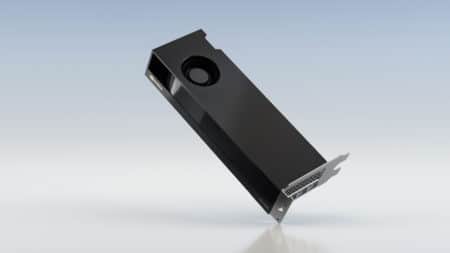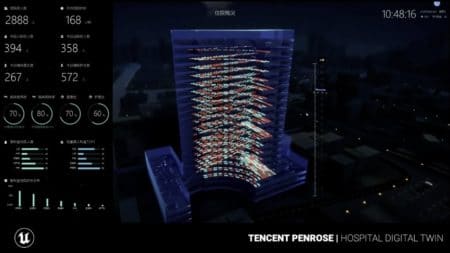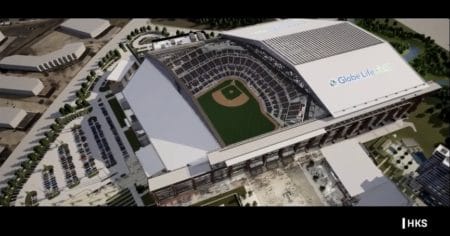GTC INTRODUCED AN OVERWHELMING AMOUNT of technology and updates for NVIDIA products. The two technologies many of us keep hearing about are Omniverse and RTX. I asked a few questions to Vice President of the Omniverse Development Platform, Richard Kerris, and Lead Marketing Strategist Andrew Rink to discuss both technologies since both are becoming mainstays of pipelines in AEC, especially in visualization.
Technologies like Omniverse Avatar and Omniverse Replicator will make working in the Omniverse a powerful tool for interacting with AI and building digital twins. All of this is driven by the effective use of RTX.
Richard and Andrew give us insight into how professionals in AEC will use these technologies for both collaborative work and visualization. Designing projects will have a new set of powerful tools to create what is in your imagination in real-time.
The Interview
(Akiko Ashley) Hello Richard, would you mind telling us about your experience in creative development with technology and how you found your way to NVIDIA?
My career spans Alias Wavefront, Apple, and Lucasfilm, which combined driving marketing and product development to bring new ideas to life. During all that time, I was a customer and a fan of NVIDIA; in fact, I presented at the first GTC while I was at Lucasfilm. It was just a matter of time until I found my home here.
Hello Andrew, can you tell us about yourself and your role at NVIDIA?
I lead industry marketing strategy at NVIDIA for AEC, based at our HQ in Silicon Valley. Part of my role is staying on top of industry trends, particularly on the technology side. I’m in my ninth year at NVIDIA; there have been some tremendous advances in technology in that time that have delivered benefits to companies all over the world.
In the future, we can envision raytracing being used much more widely than just for visualizing 3D models of buildings and products on computer displays. For example, raytraced virtual reality environments could make scenes indistinguishable from real life for an even more immersive experience.
As a side note, I’ve traveled to more than 80 countries, which has given me a global perspective on the challenges companies face, and that’s proved helpful for exploring how leading-edge technology can help enterprises transform their approach to business.
Richard, can you tell us about Omniverse and how this technology will connect architects and other professionals working together and increase their ability to collaborate in real-time?
NVIDIA Omniverse makes it possible for designers, artists, and reviewers to work together in real-time across leading software applications in a shared virtual world from anywhere.
MORE: NVIDIA’s CEO Jensen Huang Dazzles with Key Announcements and New Tools for Omniverse
Architects can meet virtually in a building they are working on. For example, a team could meet on the 36 floor—walk around the entire floor and iterate on texture details. They can also simulate what it would look like during different times of the day or how the light will reflect on the outside of the building before they have to build it in the physical world.
Andrew, can you tell us about NVIDIA RTX technology and how it has changed in the past two years?
NVIDIA RTX technology truly was a giant leap forward in compute and graphics acceleration with a fusion of raytracing, deep learning, and advanced shading.

Bentley Systems is a globally leading AEC industry software company that has recently announced it is partnering with NVIDIA to bring Omniverse technology to its building and infrastructure design applications.
With NVIDIA’s invention of RT Cores (dedicated hardware on the GPU for raytracing) and Tensor Cores (for hardware-accelerated deep learning inference), not only did we achieve a massive boost in GPU performance with RTX for various professional workloads, but for the first time, we could achieve real-time raytracing. This meant users could interactively render massive scenes at cinema-quality, which, of course, is a phenomenal boost for visualization workflows for creative professionals.
In the past two years, the NVIDIA GPU microarchitecture moved up from the Turing generation, which introduced RTX technology, to the Ampere generation. NVIDIA announced this latest GPU architecture in 2020, and it features next-generation RT Cores and Tensor Cores and doubles the GPU memory for our professional GPUs. These second-generation RT Cores and third-generation Tensor Cores offer users unprecedented graphics, rendering, and AI performance.
We recently announced the NVIDIA RTX A2000 desktop GPU, making RTX technology more accessible from a price perspective for millions of designers and architects.
Richard, can you tell us how Omniverse will bring various aspects of NVIDIA technology together in one place?
Omniverse is the culmination of over 20 years of NVIDIA technology, bringing together real-time ray tracing, AI, DL, ML with PhysX engine, DLSS, etc.
Omniverse Enterprise runs on certified Omniverse RTX/workstation configurations.
Richard, can you explain the role of USD in Omniverse?
Pixar’s open-source Universal Scene Description is the foundation of Omniverse. It enables large teams to work simultaneously across multiple software applications on a shared 3D scene. This open standard foundation gives software partners multiple ways to extend and connect to Omniverse, whether through USD adoption and support, building a plugin, or via an Omniverse Connector.
Richard, can you talk about the Physics extension developed by Apple, NVIDIA, and Pixar and how it works?
Apple, Pixar, and NVIDIA have collaborated to bring advanced physics capabilities to USD, embracing open standards to provide 3D workflows to billions of devices.

NVIDIA recently brought its RTX technology to its Ampere-architecture-based A2000 desktop GPU, making RTX technology more accessible from a price perspective for millions of designers and architects.
Rigid body dynamics is the first part of this, and there’s more to go. The important thing is that companies are working together on this critical initiative. In much the same way HTML unified the web experience, we believe that USD will do so for 3D virtual worlds.
Richard, do you need RTX GPU to use Omniverse, and does Omniverse support first-generation RTX GPU’s? Do CPU cores matter with Omniverse?
Yes, you need an RTX-based machine to use Omniverse. That is correct. Optimally, it will be a better experience to use a GPU card with a good amount of memory.
Andrew, can you talk about accelerated raytracing using RTX and how it works, and how it will develop in the future?
Raytracing is massively computationally intensive since it calculates the color of the pixels you see on your computer display by tracing the path that light would take if it were to travel from your eye throughout the scene you’re viewing.
For example, in a raytraced visualization of a building interior with physically based materials and lighting, the GPU calculates how natural and artificial light is reflected off objects such as polished marble tiles or refracted by passing through glass, or how the light gets blocked by objects and causes shadows. The benefit is that what you see on your display is exactly how that building interior will appear in real life under various lighting conditions.
Until the introduction of NVIDIA RTX technology, this computationally expensive type of photorealistic rendering would take a long time.
Photorealistic real-time rendering means true to reality simulations and workflows. You can expect digital twin virtual worlds identical to the physical ones, better productions being done in real-time, and much more.
Depending on the complexity of your scene, it could take several hours to render an image when using CPUs. With NVIDIA RTX, the combination of RT Cores, Tensor Cores, and CUDA Cores accelerate raytracing calculations to such an extent that rendering becomes real-time.
The Tensor Cores speed up AI-augmented applications such as NVIDIA Deep Learning Super Sampling (DLSS) and rendering denoising. NVIDIA’s AI-accelerated denoiser was trained using tens of thousands of images, enabling it to make an intelligent prediction on what each pixel in the render should look like. This means designers can pan, zoom, and rotate their model and instantly view the render from that new perspective without having to wait a few minutes (or longer) for the image to resolve.

Twinmotion by Epic Games is RTX hardware-accelerated for real-time raytracing rendering. Tensor Cores speed up AI-accelerated denoiser algorithms to improve rendering image quality, all in real-time. (Image: screenshot from AEC industry session at GTC 21, Belinda Ercan, Twinmotion, Epic Games)
So now, design teams can quickly iterate on models using raytraced renderings with full global illumination for animations such as architectural walkthroughs.
In the future, we can envision raytracing being used much more widely than just for visualizing 3D models of buildings and products on computer displays. For example, raytraced virtual reality environments could make scenes indistinguishable from real life for an even more immersive experience.
Andrew, what is CUDA’s role in RTX?
As a bit of background, NVIDIA introduced the CUDA programming model in 2006, which opened the door to using the parallel processing capabilities of the GPU for general-purpose computing. Today, CUDA is the most powerful software development platform for building GPU-accelerated applications.
CUDA Cores are parallel processors that handle all the data fed into and out of the GPU. NVIDIA RTX GPUs have thousands of CUDA Cores (the ultra-high-end NVIDIA RTX A6000 has 10,752 CUDA Cores), which rapidly process the innumerable calculations required for fast, accurate raytracing and real-time engineering simulation, as well as boosting frame rates. So, CUDA Cores are a critical element for improving RTX GPU performance with the many design and visualization software products used in AEC.
Andrew, can you outline a roadmap for RTX & RTX GPU graphics cards in the future?
I’ve been with NVIDIA since the Kepler generation of GPU microarchitecture (five generations before the current Ampere architecture), and each new generation has delivered impressive advances in GPU technology. While I can’t share specifics on our future GPU roadmap, it’s reasonable to assume NVIDIA GPUs and drivers will continue to deliver industry-leading performance and reliability with each new generation.
Richard, how will Omniverse influence NVIDIA’s RTX technology development?
Omniverse is based on our RTX hardware for real-time raytracing, photorealistic imagery, and more. It’s built on over 20 years of NVIDIA technology. We built this platform because we use it ourselves to simulate everything that is built. We also run visualizations of the things that we are going to develop. All teams at NVIDIA work and learn together.
Richard, can you talk about how NVIDIA’s GPU technology for raytracing acceleration works with Omniverse, and what results can we expect?
The industry breakthrough of real-time raytracing made possible with RTX is truly a game-changer. Photorealistic real-time rendering means true to reality simulations and workflows. You can expect digital twin virtual worlds identical to the physical ones, better productions being done in real-time, and much more. This is the most significant change in computer graphics history, and we’re just getting started with this new platform.
Richard, can you tell us how audio works in Omniverse?
Several companies are exploring how to implement audio using Omniverse. We have basic support but are also exploring these areas with partners and developers. More to come on this topic.
Richard, can you give a simple explanation of the first steps of how a first-time user can use Omniverse and become familiar with it?
Anyone can download Omniverse in open beta if you are using an NVIDIA RTX. We have over 150 tutorials online to help you learn how to use it. The community has been great as well, customers helping customers.

A large customer in Asia is creating digital twins of their hospitals using RTX-powered Unreal Engine technology. (Image: screenshot from AEC industry session at GTC 21, Belinda Ercan, Twinmotion, Epic Games)
Omniverse is a complex software platform capable of many things. The best bet for customers is to bring their existing workflows to Omniverse and extend them. 3D creators and designers have seen immediate success when connecting their core apps to the platform and taking advantage of all the new capabilities Omniverse brings to them.
Omniverse Enterprise is more complex and is designed for multiple team members. Ideally, the facility (or firm) has development support and an experienced IT department to deploy the platform successfully.
Richard, how do you see architectural visualization harnessing the power of NVIDIA technology in the Omniverse?
AEC visualization is a key market for Omniverse because of true-to-reality simulation. We work with our software partners to extend and enhance their customers’ workflows, which allow them to utilize real-time simulations to aid in their visualizations.
Andrew, what is the role of RTX in Architectural Visualization?
With NVIDIA RTX-powered desktop and mobile workstations or a virtual machine running NVIDIA RTX vWS (virtual Workstation) software, design teams can instantly view physically accurate and predictable visualizations of how building interiors/exteriors will appear in real life.

An example of real-time raytracing powered by RTX technology inside Twinmotion. HKS is an architectural practice already working with NVIDIA on exploring Omniverse technology for their workflows. (Image: screenshot from AEC industry session at GTC 21, Belinda Ercan, Twinmotion, Epic Games).
By enabling real-time ray-traced rendering, RTX helps designers remain in the creative flow as they iterate on design options. They can quickly consider various options to create the most compelling renders faster. The accuracy and realism offered by RTX rendering with physically based materials and lighting help drive better and faster decision-making so that teams can keep projects on track under tight deadlines.
NVIDIA Omniverse provides a virtual collaboration and simulation platform for teams working on a conceptual design to collaborate in real-time on a common model and take advantage of the RTX Renderer to create beautiful renders for design reviews and competition/bid submissions.
My favorite thing about Omniverse is team building; we have some of the most innovative developers and creators from across the globe, most with a strong history in production, toolmaking, and breakthrough technologies.
RTX-powered mobile workstations and RTX vWS software enable users to be productive from wherever they are working with their advanced visualization tools. The larger GPU memory in NVIDIA RTX professional GPUs provides the capacity to work with massive, complex architectural models and scenes.
Richard, can you name any architectural firms that are testing Omniverse?
We work with several architectural firms like Foster + Partners, HKS, and KPF. Many others around the globe. We featured a few in our recent GTC events (spring & fall) and will continue to highlight the amazing work they’re doing.
Andrew, what architectural, CAD or engineering software takes advantage of RTX?
There are over 40 RTX-enabled software products, including Blender, Chaos V-Ray, Enscape, Unreal Engine. You can see a complete list here.
Andrew, what would you say is the most significant role RTX will play in the Metaverse?
Not sure I can narrow it down to just a single significant point, but for example, RTX technology could help make the Metaverse more realistic from a visual and physics-based perspective.
With real-time raytracing, we could achieve photorealistic, dynamic digital twins of everything in the Metaverse, so we’d have realistic avatar simulation and an accurate digitally built environment that respects the laws of physics.
Richard, what is your favorite thing about Omniverse, and what would you like to see happen in Omniverse?
My favorite thing about Omniverse is team building; we have some of the most innovative developers and creators from across the globe, most with a strong history in production, toolmaking, and breakthrough technologies. They have come together to build this platform, along with our software partners, and it’s revolutionizing multiple industries. These are the days we will all look back in 20 years and see it as a moment that changed computer graphics for everyone.
Thank you, Richard and Andrew, for answering these questions and helping us to understand both Omniverse and RTX.
Additional Notes
Omniverse Enterprise was released during GTC, and with this release, companies can collaborate with teams in different locations in one place. RTX is a growing technology becoming faster, more precise, and powerful with each generation. It should be noted that both are only available on Windows and Linux. I hope we see Omniverse on the Mac soon, and perhaps RTX.
An open beta for Omniverse is available here. https://developer.nvidia.com/nvidia-omniverse-platform
Image Credits
Format equates to “party with copyright” / “party with reserved rights of use.” (eg: image: Epic Games, Inc. / Architosh. All rights reserved.)
Title image credit: screenshot from Belinda Ercan’s GTC 21 session A31745 showcasing NVIDIA’s real-time raytracing technology powered by RTX inside of Epic’s Twinmotion visualization software. ( © Epic Games, Inc. / Architosh. All rights reserved.) Non-credited images are copyrighted to Architosh. All other images are copyrighted, as noted in the image credits.




Reader Comments
Comments for this story are closed